#hard water areas in india
Explore tagged Tumblr posts
Text
India is a vast country both in terms of geography and demography. There is not one but multiple reasons for the water situation to be worsening without any water solution.
For more information read our informative blog about India And Its Hard Water Crisis
0 notes
Text
Notes on a South Asian Tropical Cyrodiil (and more!)
So, many TES fans know that before Oblivion, Cyrodiil was supposed to be tropical. The most striking phrase to describe it, "most is endelss jungle", says it all. The quick and snarky explanation is that Todd Howard watched LOTR, was "inspired" by it, and that's why everything in Oblivion looks sort of like a Rennaisance Fair. In any case, I think it was a huge missed opportunity, especially in a world where most popular fantasy is European inspired, to have replaced what could have been very cool tropical enviroments with what is frankly a lame "Talos used his magic" lore retcon. You can read the 1st edition of the Pocket Guide to the Empire to see what we missed.
But it's not only Cyrodiil which we missed this way… Tamriel just makes more sense as a tropical continent. While the size and the exact location of the continent is discussed by nerdier nerds than me, I think it does make sense like this, and not only that, we have a very interesting world parallel to compare it to: India. From a tropical rainy south to the cold mountains of Skyrim, Tamriel is surprisingly similar to the Indian subcontinent, and many of its geographical quirks can be explained if, instead of assuming a temperate Cyrodiil, we go all out with that concept. This is going to be a long post, you have been warned.
So with that in mind, I'll try to make a not-so brief tour (with some evocative pictures along the way) of a rebuilt tropical Tamriel, following the rains of the moonson:
The position of Tamriel, in this case, would be roughly where the Indian subcontinent is located in real life, that is again, tropical, stretching the Tropic of Cancer (is there a name for the tropics of Nirn? Interesting to think about) Here, we see our numbers pan out well: Tamriel is mentioned to be between 4000 and 3000km across east to west and 2000 and 3000km south to north. VERY, VERY roughly, there is 4000km between Pakistan and Myanmar, and 3000km from Sri Lanka to the northern tip of Tibet. Plot that on a map, and you already can see some coincidences. Now, this is a rather average continent, not Pangea sized like some imagine Tamriel to be. This does help explain why, for example, the interior of Cyrodiil is rainy and good for agriculture instead of a desert. But it also means that it's very likely that Tamriel is ruled by monsoons. Monsoons are complex, but they basically form when there are plenty of warm places for water to evaporate (the South Indian ocean), and mountains that block cool winds from the opposite direction (the Himalayas). We have a very similar situation here, with a mountainous Skyrim on the north of a tropical Cyrodiil facing an equatorial southern ocean. So, what happens are monsoons, perhaps not as strong as IRL India, but carrying rains very deep into the continent. This would feed the rivers and the rich agricultural areas of Cyrodiil, and would have some other consequences.
So let's imagine our trip South to North. In the South, in Black Marsh, Blackwood and Lleyawiin, and Pellentine (southern Elsweyr) we would find, much like in the original lore, humid tropical climates, jungle, wetlands, and my favorite, mangrooves. I would expect mangrooves to stretch in this whole area, across rivers. In fact, one of the reasons why Black Marsh could be so hard to explore and control by the Empires at Cyrodiil would be the presence of thick mangrooves all over its coast. This is the region of Cyrodiil that would most resemble "endless jungle".
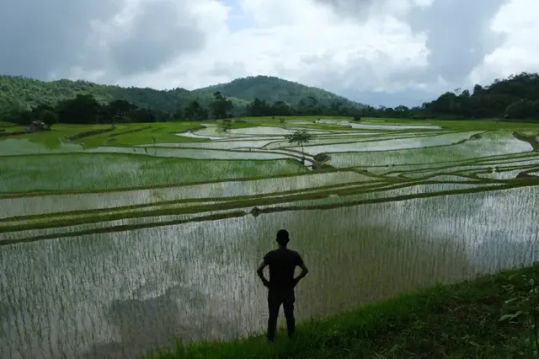
(Rice fields in India, what I imagine most of this Tropical Cyrodiil would look like)
However, as any lore person knows, Anequina, northern Elsweyr, is arid desert. Does this mean a contradiction? Far from it, we have a similar example in IRL India: the Deccan Plateau, which has a semi-arid to arid climate. This can be easily explained by higher elevations up to a small mountain chain separating it from Cyrodiil to the north, and the fact that little rain would reach behind this "Anequina Plateau" would make the region of Kvatch and Anvil more dry much like in canon, in this case, more scrublike. This highland desert would not be as harsh as Elsweyr is usually concieved, maybe, but its driest regions might justify places such as Dune. (On that matter, it always bothered me to read about the "cities" of southern Elsweyr and there being only two or three there. If I had to redesign it, I would move some from the north to the south).
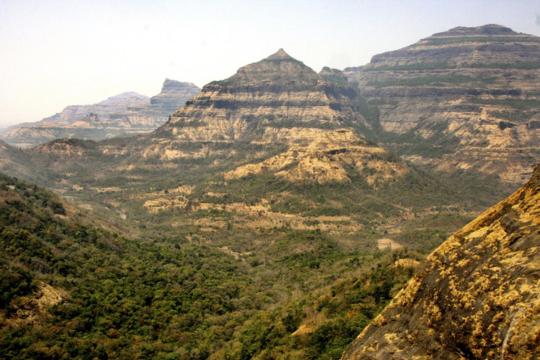
(the Deccan Plateau in India, it gets greener or drier according to the monsoon)
Keeping on our tour of Tamriel, the Topal Bay and the very rainy Black Marsh funnels the rainy monsoon from the south towards central Cyrodiil. Here we find the endless jungle of the Nibenay Valley. But unlike the rainforests of Elsweyr and Black Marsh, these dense forests and rich river plains are mediated by the monsoon winds, with dry seasons alternating with copious rain. This has huge effects on agriculture and culture in general, as agriculture is defined by the rythms of the rain. Keeping with our South Asian theme and the 1st edition of the Guide to the Empire, Cyrodiil would have huge extensions of rice paddies, as well as terrace farming and much hardier crops in the highlands, instead of the… well, almost absent agriculture we saw in Oblivion. The food, clothing, architecture and overall culture of Cyrodiil would be very different with this. The original Pocket Guide said some of its main exports besides rice and fruit are moon sugar and silk. Moon sugar in Cyrodiil, can you believe it?
Another thing I imagine Cyrodiil would be famous for would be fish and seafood, well, river food. Rice plantations can host fishes and crustaceans to get some extra protein, and well, what about mudcrabs? Hell, as preparing muddy soil is vital for rice cultivation, no wonder mudcrabs are considered a nuisance. Imagining critters in gameplay in such an enviroment also makes my mind roam. Tigers, elephants, rhinoceros, and this is not even getting into the more mythical creatures you could find, instead of endless wolves… Rice cultivation is also more labor intensive than other crops, and it also has a deep impact on the terrain, "terraforming" so to say, huge expanses into paddies and terrace farms. This level of cultivation also requires an established infraestructure of irrigation. While this does not necessarily means a centralized goverment, as farmers can build it and maintain it by themselves, the rise of an empire, i.e., the Empire, will also increase the complexity of these systems, adding canals, dams, reservoirs and more ambitious projects, like we see in India and China. I am sure some people more knowledgeable about those cultures can comment more.
While this Cyrodiil is a tropical/subtropical region covered in "endless jungle", some parts might indeed resemble the rolling hills and grasslands you see in Oblivion. Deforesting jungle for pasture is something very common around the world (some have joked this mass deforestation was later in canon explained as a gift from Talos lol) and you can see the results, like in tropical Australia and my closer Mata Atlantica, do superficially resemble temperate pastures in say, Europe. Until you notice the palm trees, of course. But yes, I can see the Nords being a mostly herding people (more on that below) bringing their sheep and cows to the tropical lowlands and, well, deforesting to make space for them.
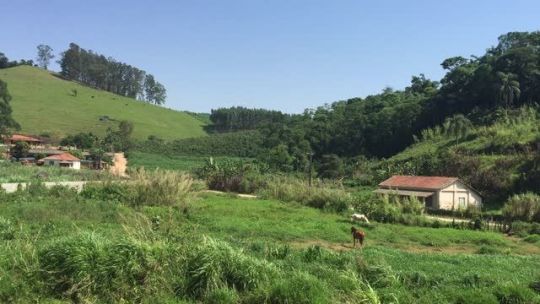
(ranches in Sao Paulo state, Brazil, notice the palm trees)
Imperial City just so happens to be built in an island in the middle of several river crossings, in what seems to be a swampland. The first thing that came to mind when I read that was Tenochtitlán. The districts of Imperial City would have been built over the centuries on artificial islands on a shallow lake, using plentiful mud and organic matter to make fertile chinampas. I believe this would make for a striking sight. Instead of just a city in the middle of a empty island, you would see the White-Gold tower and the rest of Imperial City rising from Lake Rumare, surrounded by rich farmland and its districts joined by walkways. (much like the old descriptions, actually, could you believe I wrote that without reading them?)

(Reconstruction of Tenochtitlán... and I just noticed, it's surrounded by (volcanic) mountains too, much like Imperial City)
Much like the Pantanal is one of the sources to the Paraguay River (which merges with the Paraná and then the Río de la Plata) IRL, here, the swamps of central Cyrodiil would be the source of the Niben. This does raise an interesting question, where is the source of the Niben? Is it Lake Rumare? No, I believe it would be several smaller rivers all the way from Bruma and even Skyrim. These small, violent mountain rivers eventually flow into the Rumare wetlands and only THEN in the placid great Niben. You DON'T want to be caught in one of the mountain valleys in rainy season. This does raise the question; won't the developments upriver, like Imperial City itself and the surrounding farmland, affect the course of the river downwards? There's plenty of water from the rain, but a more developed Cyrodiil might indeed have to grapple with this, supposing, for example, they manage to dam the river.
Looking west, we got the Colovian region, said to be composed of drier highlands and cliffs in the early Pocket Guide. Probably cut from the rain because of the Anequina Plateau, this is indeed more arid or "mediterranean", though I actually see it as more Australian. Maybe some of the drier parts near Hammerfell, resembling Argentine Cuyo and the northwest, would be a distant cry from the wetlands, having thorny dry forests and dry valleys, where yes, you could plant wine. The wetter cloud forests (much like the Yungas in South America, the place where the rain reaches last) could maybe be the home of the last pre-Imperial cultures of Cyrodiil. Fascinating places.
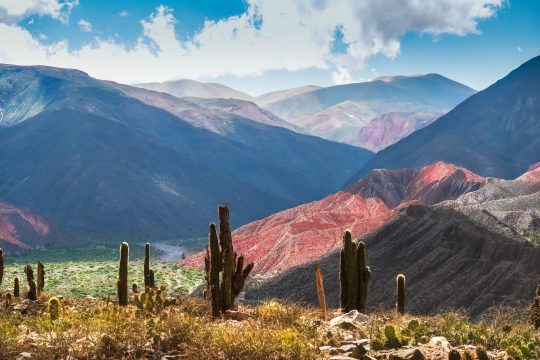
(Jujuy, Argentina. Just *near* are the Yungas cloud forests, where the last rains from the Atlantic meet the Andes, making for some AMAZING places)
Given that I mentioned enviroments near to/on the Andes IRL, let's talk about potatoes. Potatoes are unique crops, because they are the only ones who offer such calories and also be planted in cold enviroments like Europe. Or Skyrim. The discovery and spread of potatoes would cause demographic shifts on people living in cold areas. And they also originated in a unique enivorment IRL: the Andes, actually with possible hybridization from the Magallenic foresWHAT I MEAN, is that potatoes are very important and have been domesticated in very specific conditions. The Wroghtgarian Mountains would seem like a perfect equivalent of the Andes at the first glance, but they would be very different. The Andes, located between the Pacific Ocean and the greater Amazonian region, are very, very unique enviroments. These mountains, however, are in between inner seas. Something like the Atlas or the Alps? In any case, if there is some people who would appreciate hardy tubers that can grow in mountainous places, they are for sure the Orcs, or perhaps the Reachmen. Maybe an hybridization even between them?
This returns me back to Bruma and Skyrim. Some people (who make those excellent Oblivion mods) imagine Bruma with a Tibetan flavor. Personally, I imagine it more like Pakistan or Afghanistan, with lots of mesas and plateaus and valleys. It would look dry and rocky with some very fertile valleys by snowmelt, but it would look like a snowy wonderland on winter, indeed, Pakistan and Afghanistan are very snowy. Eventually, of course, ending up in the great barrier of the Jerall mountains and finally, Skyrim.

(the Alps? Skyrim? No, this is Kashmir on winter!)
In this scenario, Skyrim would be a quite dry place… or would it? There is no need for the Jeralls to be a straight line of peaks like the Himalayas. They could be a more "broken" series of mountains, like the southern Andes, but in any case, the rain from the south would clash into the higher mountains. Indeed, that is what actually happens in the Himalayas, the foothills of the Himalayas are some of the rainest places IN THE WORLD. These small valleys are something very unique and not very well known part of the world IRL. I can imagine the Skyrim equivalent would be as unique too, hard to navigate and live in. The forests of the Rift and Falkreath would be mazes of windy forests valleys, each with their own unique secrets under a perpetual fog and drizzle. This is a very interesting enviroment to imagine, where again, some of the older cultures of Tamriel could still live.

(forests of Bhutan, note how the humid valleys stretch into the distance before the cold Himalayas begin)
However, what does Skyrim look like once you cross the border with Ralof? I imagine some sort of more fertile Tibet, not as high as the Tibetan plateau, allowing for forest and alpine tundra. This is mostly because, while Skyrim is high up, I don't imagine as a plateau, but rather a series of broken mountains like the North American Rockies, which makes sense when you account for all the volcanic activity (there is another super-volcano down in Skyrim but nobody notices). I imagine that Skyrim would be a primarily herding pastoral land before the introduction of hardier crops such as potatoes, and even then. Nord culture would be very interesting reimagined like this; hillforts guarding herds of sheep and cows. It would also create a clash between the very, very agrarian south and the nomadic herding north, with High Rock and Hammerfell a gradient between the two.
But here we enter a problem; if we are operating on a level where Cyrodiil is roughly at the same latitude of India, wouldn't that make Skyrim too far from the poles to allow its tundra like climate, even with elevation? No doubt. Tibet is only as cold as it is because it's the roof of the world and far from any ocean. The northernmost tip Skyrim, like Tibet, would be at the latitude of Turkey, Korea or California, which can get quite cold, but not to the level of what we see on Winterhold or Dawnstar (Solitude sounds familiar, though). What's more, having an ocean up north would only moderate the temperature. Cool currents often don't bring cold per-se, just decrease rainfall. This would end with a very temperate and pleasant Skyrim instead of tundra. Which is on its own, interesting to explore.
Could Nirn be going through an ice age, like it's implied with the dissapearance of Atmora? Possibly, but it would imply revising everything I said before, as ice ages decrease rainfall and mess up with weather patterns all over the world. A colder Nirn would explain a lot, though.
I decide I will stop here, I haven't even touched Valenwood (though its subtropical forest seems rather coherent to me), High Rock (the most boring part of Tamriel IMO), Hammerfell, Summerset Islands (if you don't have tropical elves in your setting, you're a coward), or whatever the hell is going on Morrowind. But I hope you enjoyed this worldbuilding exercise and how to make sense of Tamriel's crazy geography. Next time, I'll try to play with tectonics and see if we can make it even more interesting.
If you liked what you read and would like more worldbuilding, consider tipping me on Ko-Fi and send me stuff to talk about, or just send an ask! I'm the kind of guy who reads encyclopedias and RPG manuals for fun, so I have plenty to talk about about everything from fantasy to science fiction to speculative evolution and alternate history!
#worldbuilding#tes#elder scrolls#skyrim#oblivion#the 'do more tropical worldbuilding you eurocentric cowards' agenda#fantasy#cosas mias#biotipo worldbuilding
400 notes
·
View notes
Text
how i've finished inktober every year for eight years and counting
Every time I mention around other artists that I finish inktober every year (meaning I draw and ink 31 drawings, one every day in October), I get questions like "how???", so I figured I'd make a post about it on the off chance it's helpful to someone. Please note that all my advice is based on my personal experience and you're a different person so what works for me may not work for you, and you can do whatever you want forever.
What it boils down to for me is two basic rules: 1) keep it simple and 2) manage your expectations.
Tools
Paper/sketchbook
I started my first inktober in my journal at the time, and because I'm neurotic like that, I've had to do every subsequent inktober in whatever journal I was using at that point.
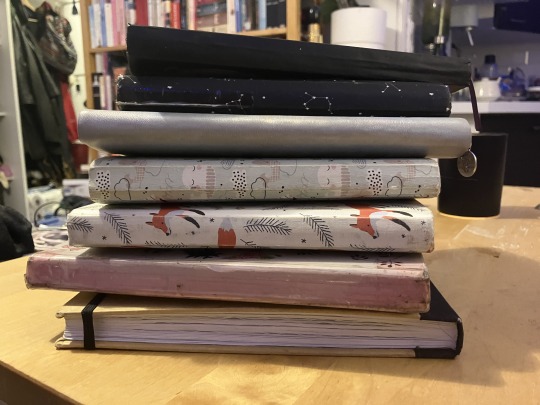
The benefit of this is that each journal has had a page size of A5 or smaller, which can be tricky when trying to get in a lot of detail, but on the other hand forces you to limit the size of your drawings to a pretty managable size.
Paper type can also be important! Last year in 2023, my journal was a Moleskine sketchbook (image 1), which was actually designed to handle some degree of wet media, which was a game-changer for me as an ink wash enjoyer. Don't get me wrong, I've been using ink washes in most of my previous journals as well, but inking is a lot nicer when your paper isn't constantly buckling (image 2) or pilling and the ink isn't bleeding all over the place, inclunding through the page (image 3). Pages that stay flat instead of buckling are also a lot easier to scan or photograph, if like me you want to post your art online.
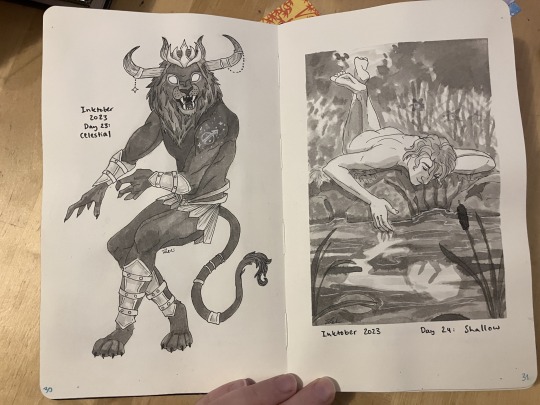
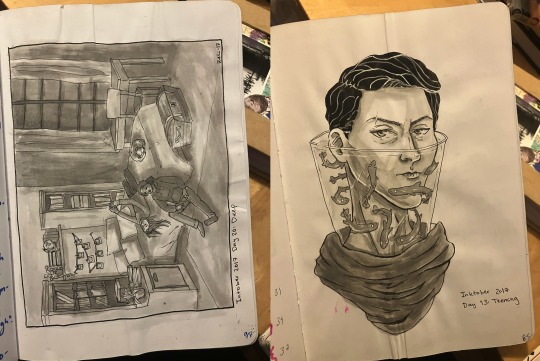

In short, my inktober paper recommendation is to use a sketchbook no larger than A5, and go for one with nice, thick paper if you intend to use wet media.
Sketching
I sketch everything with a single 6H pencil that I got from my brother in 2019. Because the lead is so hard, it allows me to scribble to my heart's content without the sketch getting too dark or hard to erase. Sometimes I'll refine the sketch with a HB mechanical pencil, which shows up really nicely on top of the 6H lines, but I may skip that step if I'm feeling lazy or the first sketch is clean enough.
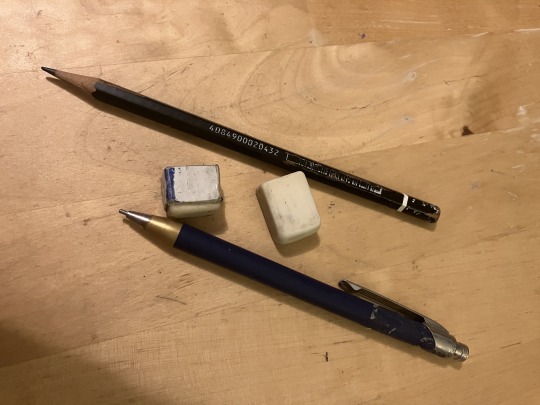
Inking
I've used a variety of art supplies in my inktober drawings. For the most part I've always stuck to greyscale, with the exception of a couple of red or gold accents some years.


My main inktober tools are a set of Micron fineliners in various sizes, and liquid India ink, which I use with a dip pen and with brushes. I usually mix up a mid-tone ink wash in a small bottle, and use that throughout the month.
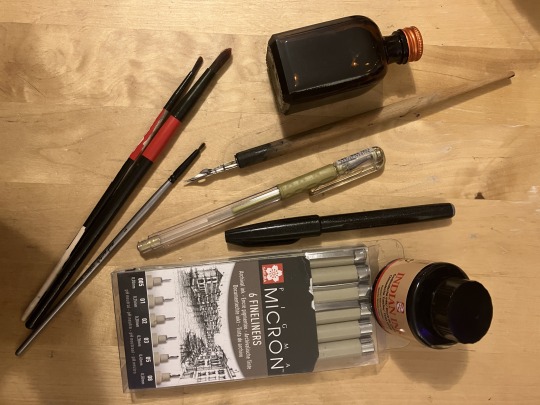
Fineliners pros: portable, require minimal setup, can use on the sofa or in bed or wherever Fineliners cons: creating texture and filling large areas is a lot more time-consuming. In 2021 I did inktober exclusively in fineliner because I was tired and couldn't be bothered to deal with liquid ink, but I ended up spending more time than maybe ever on the drawings because it took so long to add texture with pens.


Ink pros: you can achieve small details with a dip pen as well as quick texture and fill in large areas with a brush and ink washes Ink cons: can be messy (protip from 2022 Liekki, don't spill ink water all over your laptop), usually you have to sit at a table of some kind, you need to wash your brushes and dip pens, if your paper isn't designed for wet media, it'll buckle or bleed


Pick your inking tools and techniques based on how much time you have!
Prompts/ideas/subject matter
I've always stuck to the "official" prompt list, because it brings me joy to scroll through the tag of the day on instagram and see how others interpreted the same prompt. Or, rather, it used to bring me joy to do this, until instagram's enshittification stole our ability to look at tags. Maybe I'll have some luck with that on Cara going forward; here's hoping.


As for ideas, sometimes they come easy, sometimes it's like pulling teeth and I have to enlist all my friends to brainstorm with me (sorry, y'all). When in doubt, draw the first thing that comes to mind when you read the prompt; don't overthink it (like I often do). I like to try to come up with a less obvious interpretation of a prompt, but this is also where I often get stuck and have to harass my loved ones for ideas. Sometimes it helps to relate the prompt to a tv show/book/etc. you're into; I've done quite a bit of inktober fanart, as well as art of various DnD cahracters from games I've played/DM'd. If all else fails, just look at what everyone else is drawing that day.
Time management
Be realistic about how much time you have in a day to work on inktober, and then set your expectations accordingly. If you only have an hour, stick to a size and level of detail that you can realistically finish in an hour. I've done some very quick scribbles in my years of inktober when I've been busy that day.

My personal philosophy is that I try not to plan too much ahead; I don't do any sketching until day of, and ideally I don't try to come up with ideas for a prompt or at least decide on an idea until the day before at the earliest. Containing each drawing in one day helps me have realistic expectations of what's doable. This does mean drawing late into the night sometimes after procrastinating or struggling to find an idea all day, but it's what works for me.
If your goal is to complete inktober, it's better to do a small shitty drawing in ten minutes than to fall behing by starting something way too ambitious that you'll never be able to finish in a day.
Secret third rule!
Accept the fact that you aren't going to be happy with every drawing.
Inktober was created as an exercise to practice inking. Think of your drawings as sketches, not finished masterpieces. Some of them will be bad, at least in your own eyes. Sometimes you'll put a lot of effort into something that just doesn't work out. For example:


To quote Joe Hills, doing the same thing over and over again and expecting different results is the definition of practice. So you fucked up today's drawing. Tomorrow is a new day – that's the beauty of inktober. "Ever tried, ever failed. No matter. Try again. Fail again. Fail better." (Samuel Beckett) Progress isn't linear, either; some years are consistently mediocre, other years it's all over the place with a couple bangers and a couple really shitty ones.
Every inktober I've made drawings I love,


drawings I'm indifferent to,

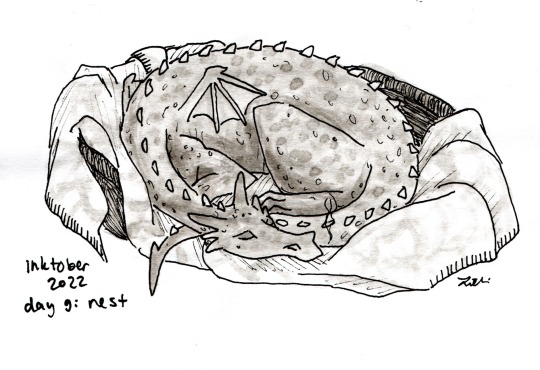
and drawings that straight up suck.


And I'm at peace with that.
Thanks for reading what turned into a pretty long post, and I hope some of it was helpful. Happy inktobering!
64 notes
·
View notes
Text
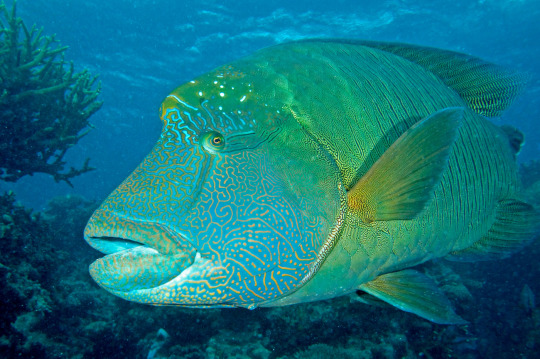
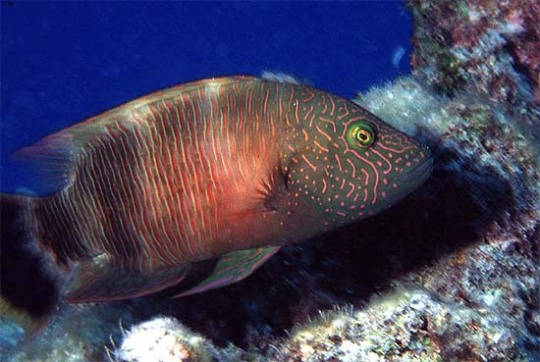
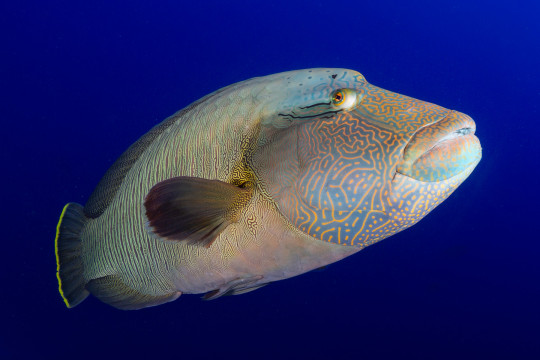
Let's Hear it for the Humphead Wrasse
The humphead wrasse, Cheilinus undulatus, is also known as the Māori wrasse, Napoleon wrasse, or the blue- tooth grouper. They can usually be found around coral reefs and steep rocky cliffs in the Indo-Pacific, particularly on the east coast of Africa, the west coast of India, and the tropical waters of southeast Asia and the Great Barrier Reef.
The Māori wrasse gets its name from the distinctive markings that adults carry. Males are blue-green or purple, while females are more often red or orange. Both have unique patterns of lines and dots covering their heads, and stripes running down the rest of their body; early researchers compared the patterns on their heads to the tattoos traditionally used by the Māori people. In addition to its striking coloration, C. undulatus is also known for being the largest member of the wrasse family. Males can reach up to 2 m (6.5 ft) long and weigh up to 180 kg (396 lbs), while females tend to be smaller. Males also have a large 'hump' on their foreheads, hence the name humphead wrasse.
Another feature of note in C. undulatus is the set of large teeth fused into a parrot-like beak. They use this beak to predate upon hard-shelled animals like mollusks, urchins, sea stars, and crustaceans. On occasion, they also feed on smaller fish and moray eels. Due to their size, adults have very few natural predators aside from sharks, but larvae and small juveniles are more often opportunistically hunted by other fish.
Like many coral reef fish, the humphead wrasse is a protogynous hermaphrodite. This means that most individuals begin life as a female, and become male later in life-- known as 'super males', they are larger than males who did not transition. Individuals first become sexually mature at 5-7 years old, and females begin transitioning to male at 9-12 years old. Spawning occurs a few times a year, and during this period over a hundred adults can congregate in an area. The female releases about 20 eggs into the water column, where they are fertilized by her chosen partner. Three to four weeks later, the eggs hatch and the larvae migrate to the nearby reef.
Conservation status: C. undulatus is considered Endangered by the IUCN. Populations have declined due to overfishing and by-catch mortalities, loss of their food sources, habitat destruction, and capture of juveniles for the aquarium trade.
If you send me proof that you’ve made a donation to UNRWA or another organization benefiting Palestinians– including esim donations– I’ll make art of any animal of your choosing.
Photos
Andrew J. Green
Lluís Masuet
George Ryschkewitsch
#humphead wrasse#Labriformes#Labridae#wrasses#ray-finned fish#bony fish#fish#marine fauna#marine fish#coral reefs#coral reef fish#indian ocean#Pacific Ocean#indo-pacific#animal facts#biology#zoology#ecology
109 notes
·
View notes
Text
Navratri is over and I have so much wisdom to share:
1. Stay AWAY from tall boys who move their shoulders a lot. You'll know when you see em. They'll break your nose, not even say sorry, and continue doing garba.
2. Always, always, choose your chaniya choli very carefully. The volume will look good, sure, but while doing garba?? Other people will step on your lehenga with NO issue whatsoever. So, especially if you're a beginner, make sure your chaniya choli will be comfortable. Otherwise, you're gonna do garba while princess holding your skirt.
3. Always have a water bottle in your vehicle. And even if you have that bottle, drink water in breaks too. Even if you have to buy it at an overpriced rate.
4. Stay away from middle aged aunties. They have too much enthusiasm and you will end up on the ground, clutching your face and crying because their bangles hit HARD.
5. Send the location of your parking place to yourself in case you're parking in a large ground, so you can find your vehicle better.
6. Always, always have something sweet in your vehicle. After the garba, you'll need the energy.
7. Perfume. PERFUME.
8. Keep a jacket on yourself. Late night, you'll want to feel covered, considering how safe India is for women.
9. Continuing the previous point, if you are, at any point, going to be alone on the road, even if it's a five minute differencr, send your live location to someone who will stay up late until you tell them you're safe home.
10. EAT something. Ffs. But never accept anything with a broken seal.
11. Always look at your feet while walking to the parking area from the ground itself. Enthusiastic people will have broken their jewellery and it WILL be lying on the ground. Trust me, you do not want to step on an earring.
12. In case you don't have pockets and have no access to someone who has pockets, clip your vehicle key to your bangles. Also works for defending yourself, if need be.
13. Don't reveal how much money you have on yourself. We know ourselves, we keep money on the mobile cover. Don't open that cover in front of a seller.
14. Establish a code of communication with your group of friends when you are driving. For example, three long consecutive horns, to indicate you can see them. And one long horn, to indicate you cannot find them. Will help to stick together.
15. Enjoy. Ik it's frightening to be out and about at night in these times, but take all the precautions you can, and close your eyes, pray to Mataji, and let her protect you.
#desiblr#suffer ye suhana nahi#desi tumblr#Navratri#ig its late for this now but next year yaad rakhna sab#and those who are going in ratri after Navratri too#make sure you're safe#and do not hesitate to hit someone who keeps bumping into you#ek baar maar doge to vo khud hi shift ho jayenge
41 notes
·
View notes
Text
Wildfires engulfed vast swathes of South America last year, devastating ecosystems, closing schools and grounding flights. With its worst fire season on record, Bolivia was especially hard hit. “We felt powerless and angry to be unable to protect what is ours,” says Isabel Surubí Pesoa.
Large ranches and farms often use fire to clear land for crops or to graze cattle. Chronic drought, fuelled by the climate crisis and El Niño weather patterns, combined with weak environmental governance, made it easy for these fires to spread out of control, destroying forests and grasslands.
Industrial-scale land clearances without fire is also a major cause of deforestation, undermining the resilience of communities and ecosystems alike.
With insufficient local and national government support, many people are left to battle fires with little more than shovels and small water bottles. “As elected officials, we feel impotent,” says Verónica Surubí Pesoa, a city councillor in San Javier and Isabel’s sister.
Forest loss in Bolivia and across Latin America is part of a broader worldwide trend. New data released earlier this week by World Resources Institute’s Global Forest Watch found that global forest loss reached record highs in 2024, with almost twice as much tropical primary forest lost in 2024 as in the year before. That is equal to an area larger than Ireland.
Deforestation in the Amazon means warmer temperatures and decreased rainfall, with consequences for farmers and food production. When fire is involved – as it increasingly is – communities report issues from water pollution and smoke, which might increase lung cancer and susceptibility to infections, to disruption to education when schools are forced to close.
Historically heavy rainfall followed Bolivia’s drought and fires in 2024, flooding towns and destroying crops. In the Surubí community, in the country’s tropical dry forest region, they disrupted growing seasons and damaged roads and bridges, further complicating recovery efforts.
Fire – which is not a natural part of tropical ecosystems, as it is in much of Australia, for example – was the leading cause of the loss of tropical primary forest for the first time recorded. Forest loss in tropical regions is especially grave as these ecosystems are some of the world’s most biodiverse and serve as key carbon sinks.
The greenhouse gas emissions from tropical primary forests lost in 2024 alone exceeded the annual carbon emissions of India. Major fires swept Canada and Russia’s boreal forests as well, and overall tree cover loss reached all-time highs across the globe.
Peter Potapov, co-director of the University of Maryland’s GLAD Lab, which collected the data, says: “If this trend continues, it could permanently transform critical natural areas and unleash large amounts of carbon – intensifying climate change and fuelling even more extreme fires.”
Although the loss of vegetation occurs across the world, Latin America has witnessed much of this catastrophe with Brazil losing the most tropical primary forest of any country. The Amazon biome saw its worst decline since 2016, with primary forest loss more than doubling, driven by fires and agricultural expansion.
After a dip in 2023, Colombia’s primary forest loss rose by 50% in 2024, though fires were not the main driver. Joaquin Carrizosa, an adviser for World Resources Institute Colombia, says: “Most of the deforestation dynamics are associated with larger macro-criminal networks interconnected through the basin and … with other countries. This is not just a Colombian problem.”
Loss of primary forest surged elsewhere across Latin America. Fires were the biggest cause in Belize, Guyana, Guatemala and Mexico. Nicaragua lost nearly 5% of its primary forest in 2024 – the highest proportion of any country.
Bolivia’s primary forest loss increased by 200%, reaching 15,000 sq km (6,000 sq miles) in 2024. For the first time, it ranked second to Brazil in tropical primary forest loss and surpassed the Democratic Republic of Congo, which has more than twice its forest area.
This “signals that Bolivia has become a major driver of the global climate and ecological crisis,” says Stasiek Czaplicki Cabezas, a Bolivian environmental economist.
Czaplicki Cabezas says the expansion of industrial-scale farming and cattle ranching, weak enforcement and oversight of environmental regulations, and a legal and political framework that values land conversion over protecting forests drove the increase in Bolivia.
“What makes 2024 particularly severe is the convergence of these structural drivers with a deepening ecological and economic crisis,” he says.
Isabel Surubí Pesoa says of the latest data: “We’re the guardians of our territory, but this is out of our hands.”
Yet, the data showed some successes. In Bolivia’s southern Chaco region, Indigenous communities, public institutions, civil society organisations and volunteer firefighters banded together to protect the tract of land that spans national parks and Indigenous territories.
After a devastating 2019 fire season, they invested in early warning systems and enforced land-use policy better. It helped them successfully fight back the wall of flame that had enveloped nearby areas in 2024 and 2023.
Collaboration across sectors was fundamental, says Arnold, whose Fundación Nativa supported the effort. Just as crucial were the local monitors – mostly Indigenous Guaraní park rangers – who know the area and track conditions all year to enable a fast response.
In San Javier, Isabel and Verónica Surubí Pesoa are looking towards the next fire season. The organisation of Indigenous women Isabel leads is holding workshops to train women in fire prevention and management, and a municipal strategy is being drawn up.
They are also seeking support from conservation organisations to equip a local fire brigade, as the group has no boots, helmets or fire-resistant clothing.
“Last year, we often went to fight the fires in shoes or sandals, and the fire burned them quickly,” she says. “We’re fighting so we don’t have to suffer the fires again.”
#excerpts#wildfires#south america#bolivia#brazil#nicaragua#columbia#tropical rainforest#climate change#guyana#belize#guatamala#mexico
10 notes
·
View notes
Text
Eden’s location in my AU
Rewrite is NOT canon friendly or Vivziepop friendly!
(There’s a lot under the cut so strap in)
So where is Eden? There’s a couple options.
No one location for Eden has been accepted by scholars throughout history. Though one general area is common. This area comes from Genesis 2:8 which is standardized to roughly say “Now the Lord God had planted a garden in the east, in Eden; and there he put the man he had formed.”
This East is commonly interpreted to mean what we in the modern day would refer to as The Middle East. For the sake of clarity I’ll be using this fairly limited area to classify the Middle East.

So where in this area is Eden?
Located between the Tigris and Euphrates rivers today. Except it’s also NOT located there.
Why between the Tigris and Euphrates? Genesis 2:10-14. As before I’ll use the scripture from the New International Version of The Bible for easy clarity, “A river watering the garden flowed from Eden; from there it was separated into four headwaters. The name of the first is the Pishon; it winds through the entire land of Havilah, where there is gold. (The gold of that land is good; aromatic resin[a] and onyx are also there.) The name of the second river is the Gihon; it winds through the entire land of Cush.[b] The name of the third river is the Tigris; it runs along the east side of Ashur. And the fourth river is the Euphrates.”
That’s a lot! Let’s interpret it. There are four rivers that flow from the same source. And these rivers frame Eden.
So what happened to the Pishon and Gihon rivers? Well some religious scholars suggested that after the Flood (Noah’s Flood) the land was so drastically reshaped that Eden’s location is impossible to find.
During medieval times it was suggested by the rabbi Rashi that the Pishon is actually the Nile. However during this same period it was suggested that it was the Ganges river instead. Other theories suggested that the Pishon and Gihon were streams that flowed from mountains.
Some people believe the Garden would’ve sat on the Fertile Crescent which lies in this general area.
So let’s rule some things out. The Ganges river is outside of the search area I set as it’s in modern day India. The Nile however could work. The only issue with this and the mountain stream answers is that before we decided that all of the rivers must flow from the same source. These rivers do not.
With this in mind I think it’s time to revisit something I mentioned earlier. The idea that the land was drastically changed after The Flood and throughout time. Looking at the map of the area between the Euphrates & Tigris and the Nile we can see several bodies of water that are separated by thin slices of land. It wouldn’t be too hard to assume that the passage of time and actions of God could have separate what is now The Red Sea, The Arabian Sea and the Mediterranean Sea into different bodies of water when they used to connected.
Thus I think the space between all of them should count as our current Eden space, however we still need to narrow this area down to map out what area of Eden is which.
Thus let’s turn to another common idea. The idea that Eden lines up with one of the earliest civilizations of Ancient Mesopotamia. This works well as it’s still in line with our search area and it would make sense historically.
From a science perspective all humans are said to originate from a point in Africa. That means to me that some part of Eden should be in Africa. And what do you know? The Nile (which we’ve decided will serve as our Pishon) is located in Egypt and Egypt in Africa.
Now should all of Mesopotamia be used or just certain fragments? Well I think that this outline of Mesopotamia works quite well.

Based off all of our criteria so far this map of what would be counted as Eden fits perfectly and thus I believe the Garden would roughly end up here. It 1) Contains the Fertile Crescent. 2) Touches the Nile and into Africa. 3) Contains both the Tigris and Euphrates and the first recorded civilization of man (Mesopotamia) where Adam and Eve would have created and lived in post exile. 4) Fits within outlined search area.
So therefore that image is where our Eden is going to be. Give or take a couple inches on the actual outline as I believe it to be a little restricting with certain areas.
You may noticed I have been avoiding talking about Cush and the Gihon. To be honest this is because I have struggled to place it but I think I have found a solution.
The Gihon and Pishon are the same river. They are both the Nile.
Before you attack me let me explain. The Nile is known as more than just one river. It is split into the Blue Nile and White Nile.
This is because the flow of water changes between these two points. The reason I believe there both are from the Nile is because Cush the area the Gihon is said to flow around can be translated to mean Ethiopia. And what river flows into Ethiopia? The Blue Nile.
This also fits with the requirement that all rivers flow from the same source. Thus the Gihon is the Blue Nile and the Pishon is the White Nile.
This does mean that Eden is extended further into Africa to reach Ethiopia but I have no problem with this interpretation as I find it fitting to reach into the scientific origin of man.
Eden’s Layout
The area in between the Tigris and Euphrates is Ashur as it matches the location of the real world city Assur and matches the description of Genesis 2:10-14.
Havilah is the area of Eden located around the Nile (Pishon) and Egypt/Africa. (Once again to match Genesis 2:10-14).
Cush is Ethiopia. For the reasons listed above in the White & Blue Nile explanation.
Eden Post Sin
You might’ve noticed one big problem with my placement. I’ve said I think Mesopotamia to be what the first descendants of Adam & Eve to have made in terms of society and where the two lovers would’ve lived post exile from Eden. However it takes up the space of Eden.
So how can they be in Eden post exile? Well the banishment from Eden in my AU is less the displacement of mankind and more the banishment of the Garden itself. The perfect inhabitable place withers and dies and becomes desert and sin upon mankind’s betrayal which is why ultimately Eden will never be found. As even if you stood where The Garden of God once was, man will never return to Eden again.
AU Masterpost
#eden#garden of eden#garden of god#helluva boss rewrite#hazbin hotel rewrite#hazbin hotel#helluva boss#vivziepop critical#middle east#mesopotamia#bible verse
13 notes
·
View notes
Text
SYMMETRA lore
Satya Vaswani grew up in an extremely poor area of Hyderabad, India. Despite living in the infamous City of Pearls, in a city renowned for artistic expression and gemstones, Satya’s village was in a bad way. Starvation was rife, the water was murky, and the village was overcrowded. Satya danced to lower her anxiety, and visited temples for meals, peace, and beauty. They were the only refuge from the ugliness of everyday village life, as Hyderabadi temples are marvels of artistic work, painted in a thousand colors with large domes and statues raised to the sky.
After the Omnic Crisis, a singular corporation decided to take advantage. India, being densely populated and with millions displaced due to the crisis, was utterly overwhelmed by the scope of humanitarian work needed to put the country back together. Vishkar extended a hand. The corporation founded a new city, Utopaea, using their proprietary hard-light technology. Vishkar’s Architechs promised order. They promised peace, and full bellies with clean water in a beautiful city made of light…and all they asked for was simple obedience.
Vishkar was known for combing records, plucking children from their families. After all, once a revolutionary company considered a child gifted, there was massive pressure on the family to let the child become an Architech. It was a path out of poverty, and a child could have their stars changed with a simple sweep of Vishkar’s hand.
So it was for Satya. She was identified as being capable of becoming an Architech, by Vishkar’s inscrutable and very secretive standards. Her parents, reassured that Satya would want for nothing, were proud to hand their daughter over to the corporation.
There was one single caveat.
Satya could never return home.
She was owned by Vishkar now, and Vishkar would be all that she breathed. To become an Architech, one had to sleep, eat, work, and embody the corporation. As was traditional for Architechs, one of her arms was removed and she was given a company-provided prosthetic that could aid her in creating hard light. Lonely, isolated, and unable to even step foot in the temples she once loved, Satya buried herself in her studies. She entered the Architech Academy in Utopaea, and was assigned a live-in roommate by the name of Niran Pruksamanee. Satya found his relaxed, privileged demeanor irritating. She preferred strict schedules, clean living spaces, and for her roommates to rise and sleep on strict timelines. The other two roommates they were assigned were happy to fall into line. Niran bucked all those trends, but despite their differences Satya found herself fond of the charming Thai gentleman she lived with. The two became inseparable.
Niran, however, had a secret. He managed to create biolight, a living extension of the Vishkar hard-light. Biolight could heal, could grow just like the plants he loved…but he wouldn’t see it turned over to Vishkar. Ignoring Satya’s advice, he fled the Academy and left her alone once again. Having no friends, Satya let her studies consume her.
Satya quickly ascended to the top of her class, and was particularly gifted with bending hard light to her will. Unlike the other students, who approached their work with physics, geometry, and mathematics, Satya found a way to weave the light with the dances of her native Hyderabadi dances.
Satya caught Vishkar’s eye once again. She was taken from the Architech Academy after her graduation, and informed that she would be no mere Architech. She would be an agent of the company, sent on clandestine missions to enforce Vishkar’s will. She was given the codename Symmetra, and finally given access to Vishkar’s dark secrets. Unfortunately, having grown up with the company line, Symmetra could only see the good Vishkar was doing. Order and obedience had become her watchwords, and she willingly gave herself to the company to do their bidding once more.
Her first mission was in Rio de Janeiro, where the company was eyeing a contract to rebuild favelas in the wake of the Crisis. Symmetra was proud to further the mission; after all, how could people stand such disgusting conditions? No. Order would be established, people would be clean and well-mannered, and she would open that path. She argued with Rio’s mayor on behalf of Vishkar, and stormed out of the strained talks when the mayor showed reticence to give their favelas over to Vishkar.
Symmetra was wholly unprepared for how angry the residents of Rio would be, and stepped into the street in the midst of a riot. The tensions between Vishkar and Rio had boiled over with the help of Lucio, a local DJ and celebrity, and the favela was plunged into a full on revolution. Frightened by the sounds, smells and chaos, Symmetra lost her way. She found a young girl named Rosa, who guided her to safety, and from that day on she vowed that Vishkar would transform the favelas into a safe place for all of Rio’s residences.
Sanjay Korpal, Vishkar’s representative in Rio, was satisfied that Symmetra was so willing to…convince Rio’s mayor that the rebuild was necessary. He sent her to infiltrate their competition. After all, with no competing bids, the mayor would be forced to accept Vishkar’s hand. All they needed was a little blackmail.
Symmetra broke in, and after rifling through the Calado corporations files, found nothing. The company was running cleanly. Calado’s guards discovered her, and Symmetra was able to throw up shields to protect herself from the resulting gunfire. She rigged non-lethal traps to give herself enough time to escape, and report back to Sanjay. When Sanjay asked why she hadn’t just killed them, Symmetra responded that she only used lethal force if absolutely necessary. Killing and brutality were a waste of life.
Symmetra then broke the news to Sanjay; they had nothing on Calado, and would likely lose the contract. Vishkar’s response was simple, and immediate: so be it.
The building she had infiltrated exploded in a fiery hail, killing everyone inside and pouring down flames and broken concrete onto the favela below. The same favela that Vishkar was supposed to be renovating. Symmetra stared in shock at the display of cruelty, and leapt in to help. Her photonic barrier carved a path through the flames, and amidst the screaming of those caught by the destruction she found a trapped child. Symmetra used her hard light to pull the child free, and recognized Rosa, the same child who had guided her out of the riot. Rosa’s face had been burned beyond repair, disfiguring her for life.
Months later, Vishkar had indeed begun rebuilding Rio’s city center, damaged by the fire. As Symmetra and Sanjay looked over the brand new buildings, nestled amid the favelas, she questioned whether Vishkar had destroyed the Calado building and killed so many. Sanjay simply responded that it was the price of regrowth.
Doubt, quiet, persistent, began to grow in Symmetra’s mind. She tried to quiet it. Vishkar was surely making a better world. She had seen the proof of it…hadn’t she..?
Nevertheless, she moved on to her next mission. Burying herself in work had worked before, why not now? Sanjay and herself were sent to help a village in Roshani, called Suravasa, damaged by a recent earthquake. Vishkar’s PR representative Chandra assured them that if Vishkar didn’t start helping the village soon, they could kiss their development rights in the area goodbye. Sanjay told Symmetra to volunteer in the village. After all, she had come from humble means. Surely she could relate to these people. Symmetra was told to give the villagers anything they wanted; it would be a scant cost compared to losing development rights.
Looking over the hologram of the damaged village, Symmetra spotted something familiar. She asked Chandra what it was, and he identified the statue as that of Aurora, the first omnic to achieve sentience and the one responsible for the Awakening. The villagers would want more than hush money, Symmetra reasoned, and Sanjay tasked her with finding out what it was.
Symmetra arrived in Suravasa to open hostility. The local Governor, Ranesh Grewal, told Symmetra they wanted nothing to do with Vishkar’s evil. Architechs were not welcome. The gathering crowd of hostile villagers seemed to back him up, and Symmetra remembered the favela riots. She requested to visit a local temple, hoping to buy herself time. Hostile, the crowd seemed like they would deny her request.
Instead, a single omnic stepped forward. Zenyatta, a pilgrim to the temple, reminded them that the temples were open to all. He led Symmetra inside, and invited her to walk with him. The help Vishkar was offering would mean nothing if it came from poisoned fingers, he reminded her. She was welcome to stay, if she did him the courtesy of taking time to understand the people and the religion here. Symmetra responded that she was no pilgrim, she was an Architech here to solve a problem.
What was a pilgrim, Zenyatta responded, if not someone who journeyed to a holy place?
Taken aback by Zenyatta’s response, Symmetra reasoned that if Zenyatta’s philosophy had calmed the crowd, perhaps his way would work better than Vishkar flinging money at the villagers. She needed more information. So, she decided to keep an open mind. She walked with Zen, and he told her of Mondatta and the Shambali monks. He led her into the main temple chamber, where the shambles of Aurora’s statue stood.
Aurora had sacrificed everything to give the gift of life, true intelligence and meaning, to omnics. Omnics had awakened, as though from a dream, from their lives chained to servitude. Aurora had given them the knowledge of good and evil, the power to make their own decisions, and become true persons as precious as any human. Symmetra finally understood why the villagers had been so saddened by its damage, and was moved by Aurora’s story. Vishkar could fix it! It was only stone, she told Zen. She could build them a new temple, a new statue, anything they wanted!
Zenyatta responded that help could come in many forms. The history of the stones around them meant so much more than any new building. The statue of Aurora had been created by hands that loved her. No hard light substitute could mean as much…ever.
Symmetra had a lot to think about, and Zenyatta invited her to stay with him. He gave her a robe, and a meal. At first, Symmetra refused the offer. Vishkar paid for her meals, and she was no pilgrim! However…the colors were quite pretty. She relented, and for the first time in many years, she wore clothing not from Vishkar’s prim offices.
The next morning, she met with Zen again. She wanted to help, and what was she to do if not use Vishkar’s technology?!
Zenyatta responded by giving her a broom, and showing her where the villagers were cleaning the temple by hand. They were so ineffective! They moved stones by hand, swept with simple brooms. Yet, Symmetra found herself enjoying the work. Organizing, cleaning, sweating as humans had done for thousands of years. As they finished the work for the day, Zenyatta handed her a gift.
The monks here didn’t meditate, but rather used distinctive orbs to ponder. Orbs of Perception focused an omnic’s powers, and while rather useless to humans, were used for understanding. They could not make them hover like an omnic could, but they could feel. They could ponder. They could focus themselves around a single object and find peace. In this way, her mind could calm itself, and she could find the solution to what the villagers truly needed. This time, Satya didn’t protest. She meditated, and cradled the orb.
Over the next few days, Satya settled into life at the temple. She rose with them, ate with them, worked with them, and centered herself on the Orb of Perception. She went into the village with Zenyatta to serve food to the hungry, and while the villagers were still hostile to her, Zenyatta stood beside her. Grudgingly, the villagers began to accept Satya. She certainly wasn’t acting like a soulless Vishkar Architech.
Satya spent her evenings with Zen. They talked about her childhood, growing up within Vishkar, and the faith she had abandoned when Vishkar had taken her. Zen introduced her to the concept of Wabi-Sabi, the Japanese concept centering around focusing on the earthly impermanence of things. Appreciate all that is imperfect, for in imperfection is beauty. Scars tell stories of love and loss, missing eyes and limbs tell of resilience. Imperfection is what makes life worth living. Some might have seen the removal of her arm as imperfection…and yet it was beautiful.
On the next evening, Zen introduced her to Kintsugi, the art of repairing broken pottery with gold lacquer to make unique and beautiful pieces. Even though a bowl is shattered, it is that shattering that makes it beautiful.
Satya realized what she had to do.
Over the next few days, Satya reassembled the statue of Aurora. Instead of merely piecing it back together, she glued the pieces with hard light. The veins of Aurora’s shattering glowed with light, yellow, imperfect but beautiful in its imperfection. Satya presented the statue to the village not in her corporate attire, but in the robe Zenyatta had gifted her.
Governor Grewal, who had been so hostile to her, was in shock. The villagers were moved, and Zenyatta gifted Satya with the robe she wore and incense…she was always welcome at the temple. Sanjay was impressed with her work, but wondered why she had chosen yellow instead of the corporation’s signature blue. While blue was a beautiful color, Symmetra told him, she had chosen yellow for warmth. Love was warmth, and she had made this with love. She wanted others to feel it when they looked at the statue.
Symmetra told Sanjay that Vishkar could do more, and be more, if they acted more like this. Vishkar needed love, and empathy, and to find beauty in imperfections rather than demanding everything be brought to their rigorous standards. Sanjay admitted, grudgingly, that she was probably right.
Symmetra continues to maintain a relationship with Zenyatta to this day, and Zenyatta views her, affectionately, as one of his students.
Symmetra still seems to tow the company line with Vishkar. Her interactions with Ana, Ashe and others reflect that she will still parrot Vishkar’s tagline of improving an imperfect world. However, her interaction with Hanzo hints that she may be seeking a way out. She asks why he left his organization, and he replied that he hated the man they made him. When Symmetra asks how he knew he did the right thing, Hanzo says he didn’t. She also asks Sombra about Vishkar’s dealings with LumeriCo…but when Sombra jokes about her escaping her cage, Symmetra shuts down the conversation.
Symmetra despises chaos. She shows disgust in her interactions with Junkrat and Junker Queen, and remarks how shocked she is Torbjorn’s inventions actually function. Likewise, she shows admiration for snowflakes with Mei. Symmetra has close friendships with Niran, who teases her about his chaotic Academy habits, and Zenyatta, who encourages her growth.
Symmetra is a person still discovering herself. She was severed from her family, and largely from her culture, by a predatory corporation. While Vishkar has made her into a successful scientist and expanded her education beyond her wildest dreams…they also robbed her of much of her humanity. She is clawing it back through her friendships with Zenyatta and Lifeweaver, and slowly growing into a person separate from the corporate drone Vishkar wants her to be.
Symmetra is a soul aching for empathy and beauty, in a world where so much of it has been sanitized in the name of efficiency. She is a reminder to us all that imperfections aren’t to be eliminated…and technical advances may come at the cost of the artist if we are not careful.
(Taken from facebook group "Deadlock gang: women of Overwatch from a member there)





10 notes
·
View notes
Text
The divine blend of spices needed to make curry first reached Southeast Asia about 2,000 years ago, when the region began trading with the Indian subcontinent, according to an analysis of ancient spice residue.
The new project analyzed 12 different spice grinding tools unearthed at the ancient trading port of Oc Eo, in modern-day Vietnam, by washing them with water and chemicals. This produced hundreds of tiny fragments that the researchers painstakingly identified (to a reasonable degree of certitude) under a microscope. The results sounded like a shopping list for making curry: turmeric, ginger, fingerroot, sand ginger, galangal, clove, nutmeg and cinnamon.
“These spices are indispensable ingredients used in the making of curry in South Asia today,” the paper says.
Ancient Trading Spices
Where did all these spices comes from?
They could have come from the surrounding countryside. Farmers in Southeast Asia made many of these crops themselves, and if not, they could have imported the seeds and gotten started.
On the other hand, the turmeric could have easily come from India, where use of the spice dates back thousands of years. And the ginger and cloves may have come from India as well, or maybe China.
Cinnamon was widely traded at the time and may have come all the way from Israel.
The galangal, fingerroot and sand ginger are native to Southeast Asia and could easily have come from nearby soils. These more specialized spices are still used in the region’s curry paste.
Footed Grinding Slabs
As a testament to the spice trade’s popularity, the spice grinders made up the majority of the stone tools recovered from Oc Eo and another, nearby city called Angkor Borei. The original archaeological dig at Oc Eo found numerous footed grinding slabs, which look like little stone workbenches for grinding spices – which is what they likely were. Versions of these slabs are still sometimes used in the traditional preparation of curry.
The largest slab recovered measured 2.5 feet by 1 foot. Researchers found it buried not far from a piece of charcoal that dated to about A.D. 250, which hinted at when curry first made its way to the area.
Oc Eo
At that time, the city would have been not just importing and exporting goods but making them as well, according to the paper. Residents raised religious monuments and shaped metal tools, glass jewelry and pottery.
All the while, they would have worked to trade and process many different spices. Archaeologists working there even found an intact nut that dated to about A.D. 200, and it still “yielded a nutmeg aroma,” the paper says.
Now part of Vietnam, Oc Eo once belonged to the ancient kingdom of Funan, which maintained a base of power further up the Mekong River.
In Oc Eo, culture prospered between the first and eighth centuries, during the latter years of the Iron Age. As the site’s ancient canals filled with ships, Buddhism and Hinduism left their own marks on the sprawling complex, including a possible contribution to curry cooking. The need to dye the Buddhist monks’ robes yellow may have first prompted Oc Eo to import turmeric, the paper says.
78 notes
·
View notes
Text
I had a dream that I went to a school in India for a month or so. We were put into teams, and we just worked. We had task schedules and lunch schedules, and bathroom schedules and the like.
There was water and boats and a weird submarine that took us down to our assigned eating place.
There was glass all over the floor at one point, and I got confused and tried very hard to stay under the radar and avoid the "teacher's" ire.
And then my group was called to handle an emergency, and we had to run through this mall area (which I've seen before in MANY other mall dreams) and it was closing down for the night so we had to run through the mall, avoiding death fnaf style (I guess?) And we eventually got to the exit and had to squeeze through a tiny gap to avoid being crushed. (I've had a few dreams about getting stuck in tiny tunnels before. Scary)
#i CAN run in my dreams!#but i run weird#like I have to make swimming motions with my arms as I run#or the weirdest one#some kind of running on all fours#when I do that I am fast like lightning lol#dream
2 notes
·
View notes
Photo
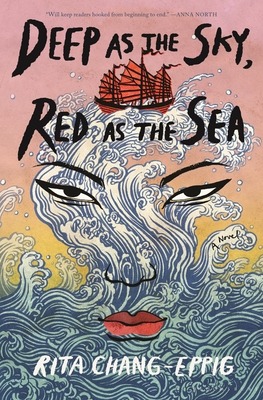

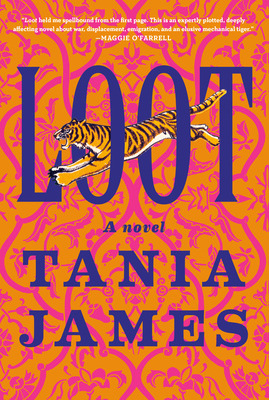
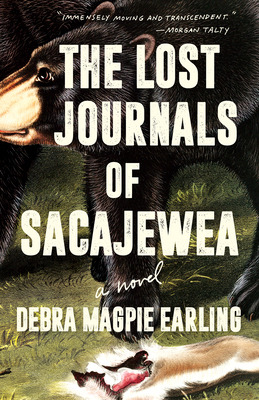
New Title Tuesday: Historical Fiction
Deep as the Sky, Red as the Sea by Rita Chang-Eppig
When Shek Yeung sees a Portuguese sailor slay her husband, a feared pirate, she knows she must act swiftly or die. Instead of mourning, Shek Yeung launches a new plan: immediately marrying her husband’s second-in-command, and agreeing to bear him a son and heir, in order to retain power over her half of the fleet.
But as Shek Yeung vies for control over the army she knows she was born to lead, larger threats loom. The Chinese Emperor has charged a brutal, crafty nobleman with ridding the South China Seas of pirates, and the Europeans—tired of losing ships, men, and money to Shek Yeung’s alliance—have new plans for the area. Even worse, Shek Yeung’s cutthroat retributions create problems all their own. As Shek Yeung navigates new motherhood and the crises of leadership, she must decide how long she is willing to fight, and at what price, or risk losing her fleet, her new family, and even her life.
A book of salt and grit, blood and sweat, Deep as the Sky, Red as the Sea is an unmissable portrait of a woman who leads with the courage and ruthlessness of our darkest and most beloved heroes.
The Long March Home by Marcus Brotherton and Tosca Lee
Jimmy Propfield joined the army for two reasons: to get out of Mobile, Alabama, with his best friends Hank and Billy and to forget his high school sweetheart, Claire.
Life in the Philippines seems like paradise--until the morning of December 8, 1941, when news comes from Manila: Imperial Japan has bombed Pearl Harbor. Within hours, the teenage friends are plunged into war as enemy warplanes attack Luzon, beginning a battle for control of the Pacific Theater that will culminate with a last stand on the Bataan Peninsula and end with the largest surrender of American troops in history.
What follows will become known as one of the worst atrocities in modern warfare: the Bataan Death March. With no hope of rescue, the three friends vow to make it back home together. But the ordeal is only the beginning of their nearly four-year fight to survive.
Inspired by true stories, The Long March Home is a gripping coming-of-age tale of friendship, sacrifice, and the power of unrelenting hope.
Loot by Tania James
Abbas is just seventeen years old when his gifts as a woodcarver come to the attention of Tipu Sultan, and he is drawn into service at the palace in order to build a giant tiger automaton for Tipu’s sons, a gift to commemorate their return from British captivity. His fate—and the fate of the wooden tiger he helps create—will mirror the vicissitudes of nations and dynasties ravaged by war across India and Europe.
Working alongside the legendary French clockmaker Lucien du Leze, Abbas hones his craft, learns French, and meets Jehanne, the daughter of a French expatriate. When Du Leze is finally permitted to return home to Rouen, he invites Abbas to come along as his apprentice. But by the time Abbas travels to Europe, Tipu’s palace has been looted by British forces, and the tiger automaton has disappeared. To prove himself, Abbas must retrieve the tiger from an estate in the English countryside, where it is displayed in a collection of plundered art.
The Lost Journals of Sacajewea by Debra Magpie Earling
Among the most memorialized women in American history, Sacajewea served as interpreter and guide for Lewis and Clark's Corps of Discovery. In this visionary novel, acclaimed Indigenous author Debra Magpie Earling brings this mythologized figure vividly to life, casting unsparing light on the men who brutalized her and re-centering Sacajewea as the arbiter of her own history.
Raised among the Lemhi Shoshone, in this telling the young Sacajewea is bright and bold, growing strong from the hard work of "learning all ways to survive" gathering berries, water, roots, and wood; butchering buffalo, antelope, and deer; catching salmon and snaring rabbits; weaving baskets and listening to the stories of her elders. When her village is raided and her beloved Appe and Bia are killed, Sacajewea is kidnapped and then gambled away to Charbonneau, a French Canadian trapper.
Heavy with grief, Sacajewea learns how to survive at the edge of a strange new world teeming with fur trappers and traders. When Lewis and Clark's expedition party arrives, Sacajewea knows she must cross a vast and brutal terrain with her newborn son, the white man who owns her, and a company of men who wish to conquer and commodify the world she loves.
Written in lyrical, dreamlike prose, The Lost Journals of Sacajewea is an astonishing work of art and a powerful tale of perseverance--the Indigenous woman's story that hasn't been told.
#historical fiction#fiction#new library books#New Books#new books to read#Book Recommendations#book recs#Reading Recs#reading recommendations#TBR pile#tbr#tbrpile#to read#Want To Read#Booklr#book tumblr#book blog#library blog
11 notes
·
View notes
Note
My favorite nineteenth-century history fact: Millions of women's decisions about how to economize their time and labor was largely responsible for the American industrial revolution. This is a long one, so buckle in, but it's FASCINATING. (Also, I'm calling it "Victorian" because most of it took place during Queen Victoria's reign, even though it began slightly before.) So to begin with: it was really hard to grow wheat in New England because of a fungus in the soil native to that area. So New Englanders grew and ate a lot of corn and rye (many at the time saw oats as fit only for animals.) The problem is, you can't really make traditional bread out of corn, and rye flour is a PAIN to work with, requiring at least four times as much kneading as wheat flour. If you're baking for an entire week at at time for a large family, that's a LOT of kneading and some very sore arms. Many New England women would mix expensive wheat flour (which they had to buy imported from Virginia or other places) with rye to make it a little easier. Then in 1825, the Erie Canal is built and prang! Lots and lots of wheat flour could be imported at low cost from the newly settled lands in Ohio, which was great for growing wheat. A lot of farm families began turning over far less space to growing grain and raised more sheep instead, which they sold to newly developed mills, both locally and in places like Lowell, whose famous water-powered textile factories opened in the 1820s. These mills produced woolens and also, most famously, cheap cotton print fabrics which women quickly realized were A.) more stylish than the homespun linen fabrics they wore most of the time, B.) WAY less labor intensive than making the fabric and thread from raw flax, and C.) a lot less expensive now that they didn't have to be imported from England or India. Household looms and spinning wheels were relegated to storage in attics, and women very quickly transitioned to making most of their clothes from factory-produced cotton. (One problem they unintentionally caused themselves in the process was that they now had to do a lot more ironing. All this new cotton fabric had to be ironed every time they washed it, and linen didn't -- at least not when washed in traditional ways without our modern detergents. So ironing ended up being a big part of the laundry process when hitherto, it hadn't been.) The major industrial cities of the Northeast began in the early 1820s with cottons, and quickly spread to other fabrics, like silks and the aforementioned woolens, and to other products. But they started with cottons, the demand for them driven by women who found ways to use them to make their daily routines a little easier. And who was going to work in those newly-built mills? Women. (continued below)
ok but what are YOUR favorite and probably real victorian funfacts?
There genuinely were some doctors who thought riding in trains would cause uterine prolapse [uterus falling out], when trains were new. The concern was that the vibrations from travelling so fast would break the fibers connecting the uterus to the abdominal wall. Unsurprisingly, this did not stop women from riding in trains. Because fuck that noise- trains!!!
One time in the 1840s a bunch of doctors shellacked live horses and rabbits and concluded, when the animals died (probably from heat exhaustion after being unable to sweat), that they had suffocated and that mammals breathed partially through our skin.
Some beauty manuals of the era may have created accidental sunscreen. Occasionally you see advice to wear cold cream on your face when going out, to prevent sunburn. This probably mostly didn't work- but some cold cream recipes contained zinc oxide for a "white foundation" effect, due to beauty standards favoring very light skin, which may have created a low-level SPF. Other manuals also advocate sealing the cold cream in with powder...which even more frequently involved zinc oxide.
A dentist may have gotten away with a malpractice death by blaming tightlacing. A 23-year-old maid named Annie Budden, of Preston, England, went to have a tooth pulled in January of 1895 and suffocated after the procedure, during which she had been dosed with nitrous oxide. The dentist said she was tightlaced and therefore the coroner ruled that he was not at fault- however said dentist claimed that her natural waist was 23" and her corset measured 18". Presumably that's the closed measurement, and corsets were commonly worn with at least a 2" lacing gap at the time (one corset ad I've seen mentions that women liked to give the theoretical closed measurement of their corset as their waist measurement, to make it sound smaller, while actually wearing it with the customary gap). Ergo, she was only laced down about 2-3 inches, a difference unlikely to cause asphyxiation. The fact that she worked as a maid similarly calls the assessment into question- how could she have successfully done physical labor while laced down in a way that diminished her lung capacity so much? Her employer vouched for her good character and excessive tightlacing was seen as vanity- and would have been noticed by making Miss Budden look out-of-proportion physically. That doesn't add up either, to me. The dentist went on to become mayor of the town where this all happened.
That thing above started as a fun fact about the only credible death due to tightlacing and then I looked into it more and now I'm just mad.
Justice For Annie Budden
Sorry this has gotten off-track but I'm still mad about the whole Annie Budden thing
2K notes
·
View notes
Text
Comprehensive Water Testing Services in India for Safe Water

Comprehensive Water Testing Services in India for Safe Water
Water is the essence of life, but its quality can significantly impact health, safety, and business operations. At The Fair Labs, we provide top-tier water testing services in India to ensure your water is safe, clean, and compliant with regulatory standards. Whether you’re a homeowner, business owner, or industrial operator, our advanced water testing solutions deliver accurate results to protect your health and environment.
Why Water Testing Services in India Are Essential
Water contamination is a growing concern across India due to industrial runoff, agricultural activities, and aging infrastructure. Unsafe water can lead to health issues, operational inefficiencies, and legal challenges. Our water testing services in India help identify contaminants like bacteria, heavy metals, pesticides, and chemicals, ensuring your water meets safety standards set by the Bureau of Indian Standards (BIS) and the World Health Organization (WHO).
Regular water testing is critical for:
Health Protection: Detects harmful pathogens and chemicals that can cause illnesses.
Regulatory Compliance: Meet government and industry standards for water quality.
Environmental Safety: Ensure wastewater does not harm the ecosystem.
Operational Efficiency: Maintain water quality for industrial processes and equipment longevity.
What We Offer: Comprehensive Water Testing Solutions
At The Fair Labs, our water testing services in India are designed to cater to diverse needs, from residential to industrial applications. We use state-of-the-art equipment and accredited methodologies to deliver precise and reliable results. Our services include:
1. Drinking Water Testing
Ensure your drinking water is safe with our thorough testing for microbial contaminants, pH levels, turbidity, and chemical impurities. We analyze parameters like E. coli, coliform bacteria, nitrates, and heavy metals to guarantee compliance with IS 10500:2012 standards.
2. Industrial Water Testing
Industries rely on high-quality water for manufacturing, cooling, and other processes. Our water testing services in India assess water for hardness, dissolved solids, and chemical composition to optimize industrial operations and prevent equipment damage.
3. Wastewater Testing
Proper wastewater management is crucial for environmental compliance. We test wastewater for pollutants, biochemical oxygen demand (BOD), chemical oxygen demand (COD), and other parameters to ensure safe disposal and adherence to regulations.
4. Groundwater and Surface Water Testing
Groundwater and surface water sources are vital for agriculture and community use. Our testing services detect contaminants like pesticides, fertilizers, and heavy metals, helping you maintain safe water sources.
5. Specialized Testing for Specific Needs
We offer customized testing for swimming pools, aquaculture, and construction water, ensuring safety and quality for specialized applications.
Why Choose The Fair Labs for Water Testing Services in India?
With years of experience and a commitment to excellence, The Fair Labs stands out as a trusted provider of water testing services in India. Here’s why clients across the country choose us:
Accredited Laboratories: Our labs are NABL-accredited, ensuring reliable and standardized testing.
Expert Team: Our scientists and technicians are highly trained in water quality analysis.
Advanced Technology: We use cutting-edge equipment for precise and timely results.
Nationwide Reach: We serve clients across India, from urban centers to rural areas.
Customer-Centric Approach: We provide detailed reports and actionable recommendations tailored to your needs.
Visit The Fair Labs to learn more about our services and how we can help you ensure water safety.
The Process of Our Water Testing Services
Our water testing services in India follow a streamlined process to deliver accurate results:
Sample Collection: We collect water samples using sterile, standardized methods to avoid contamination.
Laboratory Analysis: Samples are tested in our advanced labs for physical, chemical, and microbiological parameters.
Detailed Reporting: We provide comprehensive reports with clear insights and recommendations.
Consultation: Our experts guide you on corrective actions if issues are detected.
Common Contaminants We Test For
Water quality can be compromised by various contaminants. Our water testing services in India cover:
Microbiological Contaminants: Bacteria (E. coli, coliform), viruses, and pathogens.
Chemical Contaminants: Heavy metals (lead, arsenic, mercury), pesticides, and nitrates.
Physical Parameters: pH, turbidity, color, and odor.
Organic Pollutants: Volatile organic compounds (VOCs) and industrial chemicals.
Who Needs Water Testing Services in India?
Our services cater to a wide range of clients, including:
Homeowners: Ensure safe drinking water for your family.
Businesses: Maintain water quality for commercial operations, such as restaurants and hotels.
Industries: Comply with regulations and optimize water-dependent processes.
Municipalities: Monitor public water supplies for community safety.
Farmers: Test irrigation water to protect crops and soil health.
The Importance of Regular Water Testing
Water quality can change due to environmental factors, seasonal variations, or infrastructure issues. Regular testing ensures ongoing safety and compliance. By partnering with The Fair Labs for water testing services in India, you can proactively address water quality issues before they become costly problems.
How to Get Started with The Fair Labs
Ensuring safe water is just a click away. Our team will guide you through the process, from sample collection to result interpretation, ensuring you have the information you need to make informed decisions.
Conclusion
Safe water is non-negotiable for health, business, and environmental sustainability. With water testing services in India from The Fair Labs, you can trust that your water is safe, clean, and compliant. Our NABL-accredited labs, expert team, and advanced technology make us the go-to choice for water quality testing across India. Don’t compromise on water safety—contact The Fair Labs today at our website to schedule your water test and take the first step toward a safer, healthier future.
0 notes
Text
Delhi Best Buy Best WPC Products: City Construction
Delhi architecture is also transforming at a record speed, with ancient mystique being combined with modernity. Such an overhaul is accompanied by the production of products that are not only practical and strong but also eco-friendly and trendy. Welcome Wood Plastic Composite (WPC) welcomethe new-generation answer to all these needs. Frontage Exteriors, India's first WPC manufacturing firm, offers quality products which make homes and business complexes in Delhi and the country as a whole more beautiful.

Why WPC is Ideal for Delhi’s Climate
Delhi’s challenging climate, with its intense heat, heavy monsoons, and cold winters, often damages conventional materials like wood and metal. WPC, however, offers unmatched resilience:
Weather Resistance: Unaffected by humidity, heat, or frost.
Termite and Rot Proof: WPC is not damaged by natural wood pests and rot.
Low Maintenance: No repairs, polishing, or repainting need to be done frequently.
Eco-Friendly: Made from recycled materials, a step towards green building.
Multi-Purpose Uses of WPC Products
Frontage Exteriors has varied architectural applications for various WPC products:
WPC Louvers
Give clean and pleasant looks to exterior facades.
Give shadowing and greater energy efficiency.
WPC Decking
Spotless for patio, balcony, swimming pool area, and garden use.
Weather and slip-resistant for outdoor use.
WPC Wall Cladding
Offer natural wood finish look for interior as well as exterior application.
Moisture and UV-proof for long-lasting life.
WPC Pergolas and Rafters
Perfect for contemporary and functional outdoors.
Weather-proof and termites-free.
WPC Fencing and Gate
High-tech long-lasting boundary demarcation solutions.
Available in variety of designs and finishes.
WPC Profiles and Planks
Affordably low-priced for ceilings, partitioning, and as centerpiece.
Why Frontage Exteriors?
Frontage Exteriors being the pioneer in WPC business has been the stuff of legends with its passion for quality, innovation, and customer satisfaction. Below are the reasons why they stand as the market leader in WPC products:
Uncompromised Quality
Every product is tested hard to ensure quality and deliver performance and longevity.
Innovative Design Solutions
From traditional wood grain to strength-defying modern finishes, Frontage offers an appearance to tempt all senses.
Environmentally Friendly Production
Decreasing environmental impact with recycled material content emphasizes saving the planet.
Solutions Tailor-made
From residential, business, or commercial use, solutions are diverse in uses.
Expert Support
Skilled experts offer design, fit-out, and servicing.
FAQs
Q1. How is WPC different from regular wood?
WPC is weather and insect-proof and extremely low maintenance as against wood.
Q2. Will WPC function even outdoors in Delhi?
Yes. WPC can withstand the climatic conditions of Delhi with ease and thus extremely well suited for outdoor applications like decking, cladding, and pergolas.
Q3. Is customer choice possible while designing WPC products?
Yes, Frontage Exteriors has sufficient scope for customization like color, texture, and finish.
Q4. Is WPC eco-friendly?
Yes, WPC is a recycled material product, as per green and sustainable building norms.
Q5. Is WPC low-maintenance?
Low maintenance—every now and then soap and water washing is all it requires.
Frontage Exteriors: Your Top Pick for Front Porches
Revolutionarily Increased Durability: Waterproof, sun-resistant, and crackproof, with long-term reliability.
Flexible Aesthetic Alternatives: Outstanding variety of designs, textures, and finishes to complement any project.
Ecologically Friendly Discovery: Environmentally friendly products that respond to today's call for green building.
Proven Expertise: Rely on by top architects, designers, and developers throughout Delhi NCR.
Seamless Service: Comprehensive support from product selection to project completion.
Shaping Delhi’s Skyline with WPC
From South Delhi luxury residencies to Connaught Place commercial business space and Gurgaon residential housing complexes, Frontage Exteriors has pioneered Delhi NCR real estate metamorphosis. Its WPC series is the pinnacle of strength, beauty, and sustainability and thus the builder's and owner's first and foremost preference.
Ready to take your spaces to the highest level in WPC solution quality? Partner with Frontage Exteriors for uncompromising excellence and top-shelf design.
Call Frontage Exteriors today for details on their entire lineup of WPC products and make your building dreams a reality!
#ecofriendlydesign#weatherresistant#innovativedesign#sustainablematerials#wpclouvers#woodtexture#durablelouvers#woodplasticcomposite#exteriordesign#lowmaintenance#exterior product#outdoor product#exterior product in delhi#best exterior product#wpc products#outdoor product in delhi#outdoor products
0 notes
Text
Multi-Purpose Power Tools Every Homeowner & Farmer Should Consider

In today’s fast-paced world, the tools we use at home and on the farm play a crucial role in simplifying everyday tasks. Whether you're irrigating fields, keeping your vehicle spotless, or ensuring your home stays clean, the right equipment can save you time, effort and money. As we step into 2025, multi-purpose power tools are more important than ever.
This article explores three essential tools—water pump, best car wash machine, and vacuum cleaner—that every homeowner and farmer should consider. Let’s dive into how these machines can transform the way you work and live.
Why a Water Pump is a Must-Have for Homes and Farms
A water pump isn’t just a farming tool—it’s a utility powerhouse. For farmers, it ensures efficient irrigation, making it easier to water large plots of land, especially during dry spells. For homeowners, it’s perfect for supplying water from underground sources or managing water flow during monsoons.
Key Benefits:
Efficient Water Management: Move large volumes of water quickly and effectively.
Portable and Easy to Operate: Ideal for rural areas where electricity may be unreliable.
Saves Time and Labour: Automates irrigation, freeing you for other critical tasks.
Imagine being able to irrigate your entire field with just the push of a button. That’s the level of convenience a reliable water pump offers. And when it’s from a trusted name like STIHL, you're guaranteed performance and durability built for the long haul.
Best Car Wash Machine for Effortless Cleaning
Gone are the days of scrubbing your car with a bucket and cloth. The best car wash machine can remove stubborn dirt, dust and grime from your vehicle with minimal effort. It’s not just about keeping your vehicle clean—it’s about maintaining its value and appearance over time.
Why You Need One:
High-Pressure Cleaning: Easily tackles dirt on tyres, underbody, and engine areas.
Water Efficient: Uses less water than traditional methods.
Multipurpose Use: Can also be used for cleaning patios, garden tools, and outdoor furniture.
For homeowners, this tool turns a tiring chore into a quick and satisfying task. For those in agriculture, it’s equally useful for cleaning machinery and equipment after a hard day’s work. With STIHL’s trusted technology, you get reliable cleaning power with excellent ease of use.
Vacuum Cleaners That Keep Homes and Workspaces Spotless
A vacuum cleaner may seem like a household luxury, but in reality, it’s a necessity—especially when designed for both wet and dry cleaning. From everyday dust to accidental spills, modern vacuum cleaners make cleaning more efficient and far less stressful.
Features That Matter:
Strong Suction Power: Ideal for both soft and hard surfaces.
Wet and Dry Capability: One tool handles both dust and liquid messes.
Compact and Ergonomic Design: Easy to store and use across multiple areas.
A quality vacuum cleaner simplifies daily cleaning routines, making it an invaluable addition to homes, garages, and even small workshops. STIHL’s range of vacuum cleaners is engineered to be powerful yet user-friendly, giving you professional-grade cleanliness at your fingertips.
The STIHL Promise: Trusted Tools for Every Task
What makes these tools truly stand out is not just their functionality—but the brand behind them. STIHL India has long been recognised for crafting durable, easy-to-use equipment that performs consistently across environments. Whether you’re deep in agricultural operations or simply maintaining your household, STIHL products are designed to meet diverse demands.
By investing in:
A STIHL water pump, you secure reliable irrigation.
The best car wash machine, you protect and maintain your vehicle effortlessly.
A vacuum cleaner from STIHL, you ensure a cleaner, healthier living space.
Each tool adds immense value to your routine, enhancing productivity while reducing physical strain.
Final Thoughts
In 2025, being efficient is not a luxury—it’s a necessity. With the right power tools, you can take control of your time and energy, whether you're watering crops, washing your car, or cleaning your home. STIHL offers you the confidence to do it all—without compromise.
Looking for tools that work as hard as you do? Choose STIHL and experience the difference in quality, performance, and peace of mind.
0 notes
Text
Istg some of you use “eurocentrism” to mean “I don’t care about anything that doesn’t immediately affect me” because for damn sure you guys are not lifting up the voices of EVERY SINGLE CLIMATE ZONE CHANGE
Bruh, I live in Louisiana, we’ve had….flecks of ice once every ten years? Maybe? So yeah that’s not gonna be noticeable or different, but it IS less cold even to me in the winter and takes longer to get cold, and it is DEFINITELY HOTTER. Like, DANGEROUSLY FUCKOFF HOTTER in the summer, it’s entirely possible that due to the wet bulb effect this area may be UNSAFE without air conditioning in the near future, if it isn’t already. I know people in India and Mexico are already dying from summer wet bulb heat waves without air conditioning! People were posting about that last summer?! I was reblogging it?!
And oh, on the topic of self-interest…..lol. Lmao. Each climate zone has been having its own climate tragedies that you’re assuming people aren’t paying attention to because what, they’re talking about snow? How do you know? Were you following all these people and what they were posting? Have YOU been paying attention to the various climate disasters in various climate zones? Why the assumed bad faith for others but not yourself? Like, I get the annoyance at the previous “Hurf durf air conditioning is wasteful, everyone should give it up because climate change, people only die from freezing to death, just wear less clothes and drink more water” and like READ ABOUT WET BULB EFFECT YOU IGNORANT SLUT, PEOPLE ARE DYING. But this? Is not that. The unusual droughts and floods in the Midwest? The back to back to BACK once-in-lifetime severity hurricanes hitting the Gulf Coast?(‘They get those all the time, they’re used to it’ LOL NOT CATEGORY 4 EVERY OTHER YEAR, not hitting Lake Charles so damn often and hard you would think it’s Sodom and they can’t even recover and rebuild from the last one and people just have permanent blue tarps on their roof, not hurricanes randomly rerouting all the way up to New York and all we can think is “at least it’s not us for once”
This flippant “psst I never had snow” is missing the point entirely. If you haven’t noticed some sort of change to your climate environment, then you’re either too young, very unobservant, or don’t WANT to see it. My area’s economy RUNS on oil and gas, and it’s so obvious now that it’s the constant elephant in the room, the devil’s bargain we made that we dare not speak about because it’s frankly too depressing. It’s COMING for you, it’s just a question of how and how fast.
Christmas as a cultural icon is starting to get really dystopian in a climate sense, december has historically been a time of year in which there would be snow in a significant portion of europe and north america, and the fact that its not even icy this time of year and all the christmas songs and decorations reference a time of year that will likely never exist in the same way again in my life time is so strange.
116K notes
·
View notes